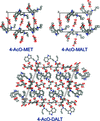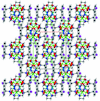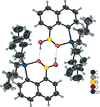issue contents
February 2021 issue

Cover illustration: In the crystal structure of [3,10-bis(4-fluorophenethyl)-1,3,5,8,10,12-hexaazacyclotetradecane]nickel(II) diperchlorate, [Ni(C24H36F2N6)](ClO4)2, the complex cation exhibits statistical (50:50) whole-molecule disorder about the crystallographic twofold axis of the space group, C2/c. Hydrogen bonding with the perchlorate anions binds the structure into a three-dimensional network. See: Kwak & Chang [Acta Cryst. (2021). E77, 148-152].
research communications
Download citation


Download citation


The title centrosymmetric decaaluminum cluster, Al10O4(OH)8(C3HF6O)14, contains two OAl4 units and a central Al2(O)2 bridge.
CCDC reference: 2052015
Download citation


Download citation


The structure of the title compound exhibits a folded conformation with the three arms all on the same side of the tertiary N atom. The crystal packing features π–π interactions.
CCDC reference: 2052908
Download citation


Download citation


The central six-membered ring of the title compound has a slightly distorted half-chair conformation while the conformation of the fused pyrrolidine ring is that of an envelope. Molecules are connected by intermolecular C—H⋯O hydrogen bonds, C—H⋯π interactions and π–π stacking interactions, forming a three dimensional network.
CCDC reference: 2053210
Download citation


Download citation


Single crystals of SnCl2·MePyNO, 1, and SnCl2·2MePyNO, 2, have been synthesized and structurally characterized by X-ray diffraction to investigate the structural changes of MePyNO as a result of its different coordination modes and the variation of the coordination geometry at the tin(II) atoms.
Download citation


Download citation


A series of unsubstituted, mono- and di-N-methylated perimidines were prepared and studied by single-crystal X-ray analysis and 1H NMR spectroscopy.
Download citation


Download citation


The crystal structures of the fumarate salts of three prodrugs of synthetic psychedelics (4-AcO-MET, 4-AcO-MALT and 4-AcO-DALT) are reported.
Download citation


Download citation


In the crystal of the title compound, which shows blue–green emission, the molecules are connected via C—H⋯Cl/F, halogen⋯π and weak π–π stacking interactions.
CCDC reference: 2053861
Download citation


Download citation


The crystal structure of a dimeric ZnII complex with picolinamide and azido ligands is characterized in the solid state and in solution.
CCDC reference: 2052868
Download citation


Download citation


A new member of the bulky N,N′-bis(2,6-diisopropylphenyl)arylamidine family is reported herein: the N,N′-bis(2,6-diisopropylphenyl)-4-pyridylamidine is a symmetrically N,N′-disubstituted arylamidine containing a 4-pyridyl substituent on the carbon atom of the N–C–N linkage and bulky 2,6-diisopropylphenyl groups on the nitrogen atoms.
CCDC reference: 2054114
Download citation


Download citation


The heterocyclic portion of the tetrahydroisoquinoline unit is planar and an intramolecular N—H⋯N hydrogen bond and a C—H⋯π(ring) interaction help to determine the overall conformation. In the crystal, O—H⋯O hydrogen bonds form inversion dimers, which are connected by C—H⋯O hydrogen bonds, forming layers parallel to (10![[\overline{1}]](/e/issues/2021/02/00/vm2243/teximages/vm2243fi1.gif) ).
).
![[\overline{1}]](/e/issues/2021/02/00/vm2243/teximages/vm2243fi1.gif) ).
).CCDC reference: 2055318
Download citation


Download citation


In the title compound, each boron atom is four-coordinated by two fluorine atoms, a pyrrole N atom and an imine N atom. Both imine CH=N groups adopt a trans conformation. In the crystal, the molecules self-assemble into a pillar structure through C—H⋯F hydrogen bonds and π–π interactions.
CCDC reference: 2055687
Download citation


Download citation


The triazene derivative, (E)-1,3-dimethyl-2-[(4-nitrophenyl)triaz-2-enylidene]-2,3-dihydro-1H-imidazole was synthesized by coupling 1,3-dimethylimidazolium iodide with 1-azido-4-nitro benzene. The title compound has monoclinic (C2/c) symmetry and an E conformation about the –N= N– bond.
CCDC reference: 2055595
Download citation


Download citation


The asymmetric unit of the title two-dimensional polymer, sodium 2-[1-methyl-5-(4-methylbenzoyl)-1H-pyrrol-2-yl]acetate dihydrate, Na+·C15H14NO3−·2H2O, contains two sodium cations, two organic anions and two water molecules. The title compound exhibits analgesic, anti-inflammatory and antipyretic activities.
CCDC reference: 2055407
Download citation


Download citation


The title compound is a Schiff base formed from 5-nitrothiophene-2-carbaldehyde and 2-methyl-3-nitroaniline. In the crystal, the molecules are linked by weak C—H⋯O hydrogen bonds.
CCDC reference: 2055920
Download citation


Download citation


The crystal and molecular structures of 2-chloro-3-nitro-5-(trifluoromethyl)benzoic acid and 2-chloro-3-nitro-5-(trifluoromethyl)benzamide, two precursors for the synthesis of 8-nitro-1,3-benzothiazin-4-ones, a promising class of new antituberculosis drug candidates, are described.
Download citation


Download citation


A new nickel(II) complex of a hexaazamacrocycle containing 4-flurophenethyl pendant arms was synthesized by metal template condensation in a one-pot reaction of formaldehyde and amines in the presence of nickel(II) ions and its X-ray crystal structure was determined.
CCDC reference: 2053166
Download citation


Download citation


The structure of a cadmium(II) aroylhydrazone complex, viz. bis{2-hydroxy-N′-[1-(pyrazin-2-yl)ethylidene]benzohydrazidato}cadmium(II) is described.
CCDC reference: 2051612
Download citation


Download citation


The crystal structures of three copper(II)-bipyridine–MF6 (M = Si, Ta, Sn) compounds and a related coordination polymer are reported.
Download citation


Download citation


Crystal structures of three compounds with the formula [Cu(phen)(H2O)3(MF6)]·H2O (M = Ti, Zr, Hf) based on bimetallic Λ-shaped molecules and a related salt with the formula [Cu(phen)(H2O)2F]2[HfF6]·H2O are reported.
Download citation


Download citation


The solid-state structure of RuPhos (2-dicyclohexylphosphanyl-2′,6′-diisopropoxybiphenyl) is presented for the first time and discussed in detail. The phosphine cone angle is computed and compared to the cone angles of other phosphine ligands.
CCDC reference: 2056274
Download citation


Download citation


In the crystal of the title compound, the formation of an intramolecular O–H⋯O hydrogen bond between the hydroxy group and the methoxy group at the 1,2-positions of the acenaphthene ring core giving rise to a five-membered cyclic organization is observed. In the molecular packing, a pair of non-classical C—H⋯O hydrogen bonds forms centrosymmetric dimeric structures.
CCDC reference: 2057372
Download citation


Download citation


A novel oxastannaborininol, 1,1-dibutyl-1H,3H-naphtho[1,8-cd][1,2,6]oxastannaborinin-3-ol, has been synthesized and crystallized. It is the first reported compound with a heterocycle containing an Sn–O–B unit.
CCDC reference: 2057745
Download citation


Download citation


The asymmetric unit of the title compound, C24H21NO4, contains four molecules. Each molecule displays intramolecular N—H⋯O hydrogen bonds and C—H⋯O interactions. The crystal packing is characterized by C—H⋯O hydrogen-bonding interactions, resulting in chain formation in the [001] direction, and C—H⋯π interactions.
CCDC reference: 2058520
Download citation


Download citation


The structures of the dimethylated versions of two natural products found in toad secretions, bufotenine and bufotenidine, are reported, as well as the hydrate of 2,5-dimethylbufotenidine.
Download citation


Download citation


The supramolecular structure of the compound is stabilized by a three-dimensional array of N—H⋯O and C—H⋯N hydrogen bonds and C—H⋯π interactions.
CCDC reference: 2058071
Download citation


Download citation


The reaction of 4-amino-1,5-dimethyl-2-phenyl-1,2-dihydropyrazol-3-one with 4-methoxybenzo[1,3]dioxole-5-carbaldehyde resulted in the title compound, which crystallizes in space group C2/c. Two solvent-accessible voids, each of 397 Å3, were found to be evident in the crystal structure.
CCDC reference: 2058001
Download citation


Download citation


In the title compound, the molecules stack parallel with the a axis with multiple H⋯O contacts involving the axial H and O atoms. Many more H⋯O contacts between the stacks exist, which mostly involve the equatorial hydrogen and oxygen atoms. The highly polarized hydrogen atoms of the –SO2—CH2—SO2– moiety make no exceptionally short H⋯O contacts but clearly play a leading role in the formation of the stacks.
CCDC reference: 2058562
Download citation


Download citation


The amine 8-{4-[(6-phenylpyridin-3-yl)methyl]piperazin-1-yl}-3,4-dihydroquinolin-2(1H)-one was crystallized as the hydrochloride salt 4-(2-oxo-1,2,3,4-tetrahydroquinolin-8-yl)-1-[(6-phenylpyridin-3-yl)methyl]piperazin-1-ium chloride. Its structure is compared to that of the salt 4-(2-oxo-1,2,3,4-tetrahydroquinolin-8-yl)-1-{[6-(4-fluorophenyl)pyridin-3-yl]methyl}piperazin-1-ium chloride monohydrate, a fluorinated analogue.
CCDC reference: 2059142
Download citation


Download citation


In the hydrated title salt, [C22H48N4]Cl4·4H2O, the cation lies about an inversion centre. The macrocyclic ring adopts an exodentate (3,4,3,4)-D conformation. In the crystal, O—H⋯Cl, N—H⋯Cl and N—H⋯O hydrogen bonds connect the chloride anions, tetraprotonated cations and water molecules into a three-dimensional network.
CCDC reference: 2059324


 journal menu
journal menu















































